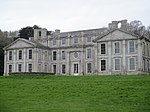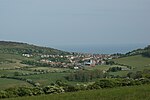Wroxall railway station
1866 establishments in EnglandBeeching closures in EnglandDisused railway stations on the Isle of WightFormer Isle of Wight Railway stationsPages with no open date in Infobox station ... and 3 more
Railway stations in Great Britain closed in 1966Railway stations in Great Britain opened in 1866Use British English from December 2016

Wroxall railway station was an intermediate station on the Isle of Wight Railway line from Ryde, situated between Shanklin and Ventnor with an upland situation. To the north lay Apse Bank with its three miles of 1 in 70 gradient and three bridges. The gradient eased in the station but increased again to 1 in 88 as Ventnor Tunnel was approached.
Excerpt from the Wikipedia article Wroxall railway station (License: CC BY-SA 3.0, Authors, Images).Wroxall railway station
Station Road,
Geographical coordinates (GPS) Address External links Nearby Places Show on map
Geographical coordinates (GPS)
| Latitude | Longitude |
|---|---|
| N 50.6159 ° | E -1.2221 ° |
Address
Station Road
PO38 3BH
England, United Kingdom
Open on Google Maps









